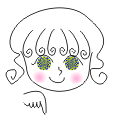Illusion designs from friends
The copyright of each image belongs to the corresponding creator, to whom contact should be addressed in the case of request for use (even if it is for educational, research or personal use).
since January 12, 2004; access since August 3, 2004

"A plane"
The plane appears to fly.
Copyright Constantin Shebzukhov 2004
Mr. Shebzukhov, Moscow, Russia, October 16, 2004
Akiyoshi's comment: Perfect!!
Seiichi's (a graduate student) comment: The rows of clouds appear to tilt clockwise.
Akiyoshi's wife's comment: Wonderful!!

"Toothed wheels"
The toothed wheels appear to rotate.
Copyright Constantin Shebzukhov 2004
Mr. Shebzukhov, Moscow, Russia, October 15, 2004
Akiyoshi's comment: Excellent!!
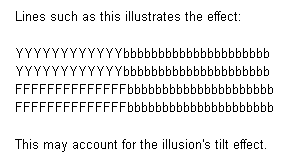
"Fesenmeyer's tilt illusion"
The rows of Y and b or F and b appear to tilt clockwise.
Copyright Fesenmeyer Phillip 2004
Mr. Fesenmeyer, Texas, USA, October 14, 2004
Phil's comment:
Character reading (human or by machine) is performed by several steps.
"Line finding" seems to apply in this case. What constitutes
a line of text is first determined by a process of "line finding."
This is the determination of where a line of text starts and ends. Shorter
lines are easier to read because the eye has less distance to scan to determine
a line. Surprisingly enough, the same is true (to a point) for computers
as line length affects their statistical accuracy evaluation of line finding.
This is why Arabic based text in newspapers and magazines are usually lines
of text characters in narrow columns to enhance readability by minimizing
line finding effort. Base line determination is critical to this analysis
(human and computer). That is, the determination of the base of the characters
in a line of text. This is always the reference line for both computer
and human visual analysis and has the strongest analytical weight in determining
a line.
Within a line, the height of the text characters can vary by 50% or more
depending on the font used. Because of this, the top of the text line is
actually meaningless, but optically to the human eye, it has a significant
impact due to the individual character's visual "mass." For example,
a b has a low visual mass, where as F has a high visual mass. That is,
the densest part of a graphical character is above or below its vertical
center point. Density of ink is visual mass. This "mass" effect,
tends to bend our visual perception of where the center is for the graphic
being observed. Visually to the eye, the center is the round bulb on the
lower case "b", not the physical center of the character, and
not at the intersection of the vertical line and the top of the round bulb.
This subtle shift in perception, caused by the visual shift of the character's
visual center point, and the mass effect causes a tilting of the perceived
top of character line and the associated base line by acute angle visual
referencing (see illustration).

Akiyoshi's comment: He kindly sent me his explanation of Imajo's tilt illusion (and Chihara's receipt illusion). I hope this will help her write the graduation thesis still better.
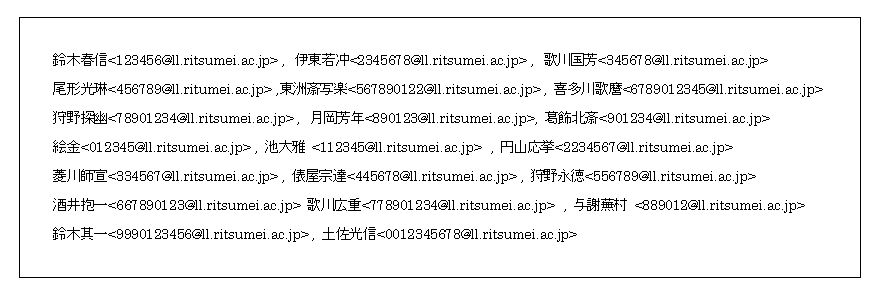
"Imajo's tilt illusion"
The rows of names and e-mail addresses appear to tilt clockwise.
Copyright Yuka Imajo 2004
IMAJO Yuka, one of Akiyoshi's undergraduate students, Department of Psychology,
Ritsumeikan University, Japan, October 5, 2004
Akiyoshi's comment: The illusion magnitude is very large for me. She started to study this illusion for her graduation thesis. I am looking forward to having the results and her discussion.
The Chinese characters show the names of famous Japanese painters.
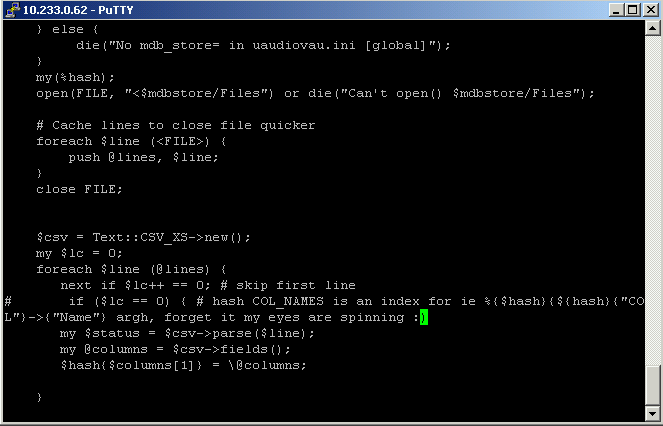
"Can't work"
There is anomalous motion illusion among the lines. According to the reporter, "I notice the illusion more toward the bottom left of the black window when scanning over the 'foreach' loop area". He also reported that smoking seemed to reduce the illusion.
Copyright Gary Shingles 2004
Mr. Shingles, Auckland, New Zealand, September 29, 2004
Akiyoshi's comment: I feel the illusion all over the image. Although I do not smoke, drinking a cup of coffee does not seem to have any effect on the illusion.
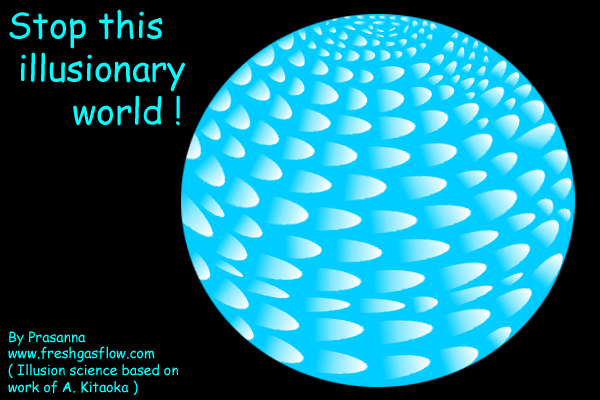
"Stop this illusionary world"
The image gives us an impression as if the earth rotated.
Copyright Prasanna Tilakaratna 2004
Dr. Tilakaratna (doctor of anesthesia), London, UK, September 22, 2004
Dr. Tilakaratna's illusion works

"Slow Chain"
The inset appears to move.
Copyright Prasanna Tilakaratna 2004
Dr. Tilakaratna (doctor of anesthesia), London, UK, September 15, 2004
Akiyoshi's comment: The idea is creative and the design is beautiful.
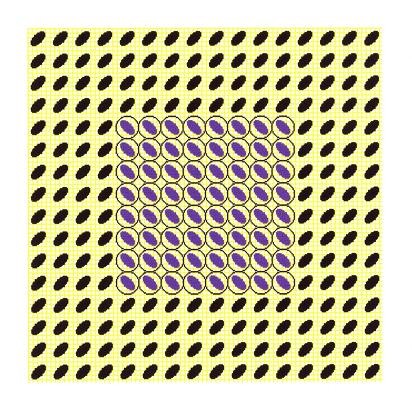
"CPU"
The inset appears to move.
Copyright Keizo Shimizu 2004
Mr. Shimizu, Kobe, Japan, August 3, 2004
Akiyoshi's comment: The illusion resembles that of Pinna and Spillmann (2002)*, but it is no doubt that he has create it by himself, and moreover the illusion might be really novel.
*Pinna B, Spillmann L. (2002) A new illusion of floating motion in depth. Perception, 31, 1501-1502.

"Sasaki's curvature illusion"
The diamond shape appears to be distorted. Left: the diamond shape appears to bulge out at the center of each side. Right: the diamond shape appears to be bent in at the center of each side.
Copyright SASAKI Takayuki 2004
SASAKI Takayuki, one of Akiyoshi's undergraduate students, Department of
Psychology, Ritsumeikan University, Japan, April 7, 2004
Akiyoshi's comment: The left image reminds us of the Bourdon illusion while the right one can be described as an acute-angle expansion illusion. I am sorry that this comment does not make anything clear... In addition, the diamond in the left image appears to be smaller than that in the right image. Furthermore, the gray square in the left image appears to be smaller or farther in depth than the black square in the right image. These additional findings might only disturb our thought...
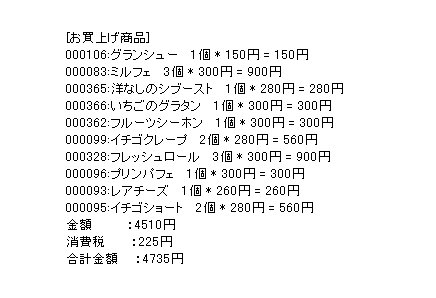
"Chihara's receipt illusion"
The rows of letters are horizontally aligned but the right side of each appears to tilt counterclockwise. This image was discovered on a PC display in a receipt of the purchase of a variety of cakes. It looks delicious.
Copyright CHIHARA Kazunori 2004
Mr. Chihara, Sapporo, Japan, February 16, 2004
Akiyoshi's comment: I am sorry I cannot explain the phenomena at all. This illusion might be novel. It does not seem that this illusion has something to do with the Zollner illusion or the Cafe Wall illusion.
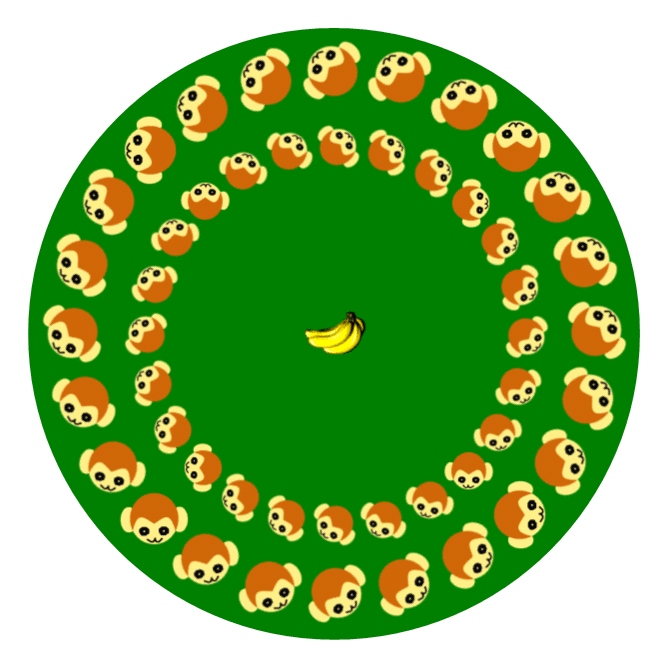
"Monkeys 2004"
The rings made up of monkey heads appear to rotate when you approach or move away from the figure with fixating at the banana. Moreover, "brown blurs" can be seen from the heads of monkeys when you approach the figure. The shapes of the blurs appear to be tapered spirals.
Copyright HATANO Tomomi 2004
HATANO Tomomi (Ritsumeikan University), January 12, 2004
Akiyoshi's comment: I cannot explain the phenomena of this positive after-image (brown blurs).
![]()
"Ishihara's icon illusion"
The file names appear to tilt clockwise. Masami Ishihara discovered this illusion.
Copyright M.Ishihara 2002, presented with permission
